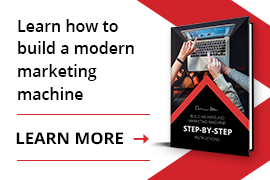
Most business owners know that marketing is essential to their success. Being profitable in business requires more than just creating a superior product or service. If you want people to actually know who you are, and transition from one-time buyers to loyal customers, you need to find a way to get the word out about your business. And this is where marketing comes into the picture. But with all the different strategies being promoted as the ultimate way to build a solid lead and sales funnel, it can be overwhelming to know which strategy to implement.
Unless you’re a marketer by trade or are experienced in the medium, terms like “inbound marketing,” “outbound marketing,” and even “integrated marketing” can sound like a foreign language. But as a small business owner, you don’t have the time to decipher obnoxious industry terminology with definitions full of meaningless fluff. So, let’s cut the jargon, break down these terms, and help you understand how you can leverage these strategies to build a loyal following.
Inbound Marketing
Inbound marketing sounds complex, but in short, it references creating compelling organic content via digital media that provides value and attracts consumers to your business. Whether your business centers on e-commerce, brick and mortar, or is service-based, the concept is always the same: Interesting content that’s relevant to your audience intrigues them and leads to inquiries, booking services, or buying a product. In this scenario, you’re building rapport with your target audience before you do business with them.
Think back to the last time you read a great article on sites like Forbes, Entrepreneur or Inc. Often, this content was written by a “thought leader” in a particular field and included a byline with the author’s bio and business information. In this scenario, the article served as a value-add to prove that the author was a subject matter expert. If you found the article useful, you might have even clicked through the author’s byline to visit his/her website to either contact him/her or to learn more about that person’s business. This is effective inbound marketing.
Inbound marketing is NOT:
- Telemarketing
- Pitching emails to recipients who DID NOT specifically opt-in to your email list
- Annoying pop-up ads begging people not to leave when they mouseover your page tab in their browser
- Comment spam on other blogs, articles, or forum sites
Inbound marketing shouldn’t feel forced or disruptive to your target audience. Positive examples of inbound marketing can include the following:
- Email outreach to an opt-in list
- Guest blog content
- Influencer marketing
Outbound Marketing
Depending on who you talk to, outbound marketing might be frowned upon. While inbound marketing is meant to be unobtrusive and focuses on value and relationship building, outbound is all about the numbers game. Your goal is to get your business seen or heard by the largest number of people possible through “traditional” marketing methods.
Common outbound methods include:
- Television/radio advertisements
- “Cold-calling” via rented lists
- Mass emailing via rented lists
- Internet ads
- Affiliate marketing (i.e. Linkshare, Affiliate Junction)
Is There a Compromise Between Inbound and Outbound?
Based on the inbound and outbound marketing definitions, it might seem like the two can’t work together. But this isn’t true. Integrated marketing, much like the name implies, is all about blending the two methodologies to create a balanced strategy that leverages the strengths of both concepts.
With integrated marketing, the focus is on developing a unified message that can be carried both organically via inbound, and as a stand-alone call to action (CTA) for outbound marketing.
What Does an Integrated Marketing Campaign Look Like in Real Life?
A great example would be a brand creating a strategy that uses highlights from an influencer campaign and placing elements of that across outbound channels like (rented) emails, social media ads, and in press releases to major media outlets.
The influencer campaign centers on leveraging the strength of each influencer’s reputation within their individual audiences to drive organic engagement and build rapport between their audience and your brand (read inbound). But this strategy will also net your business relevant content that can be repurposed for general marketing opportunities to a larger audience (read outbound).
Here are a few more real-world examples of effective integrated marketing.
How to Create an Integrated Marketing Strategy
Now that you know more about integrated marketing, what should you keep in mind to create a winning strategy?
- Your marketing team should be collaborative, not working in silos. Merging “traditional” media with newer digital media can require a serious learning curve. Make sure everyone is on the same page to avoid missteps.
- Consistency is key. Whether someone finds you on LinkedIn, Instagram, or through a Google ad, your messaging and visuals should be consistent across all platforms.
- Data is king. It’s impossible to launch an effective integrated marketing campaign if you don’t look at the numbers. You need to know where your audience spends their time and look at historic response trends in order to predict where your time and marketing budget should be allocated.
Of course, as a business owner, knowing what needs to be done and having the time or manpower to devote to it are two different things. In addition to being an award-winning design firm, The Creative Momentum is also well versed in developing and implementing cutting-edge marketing strategies that can catapult your business to the next level.

